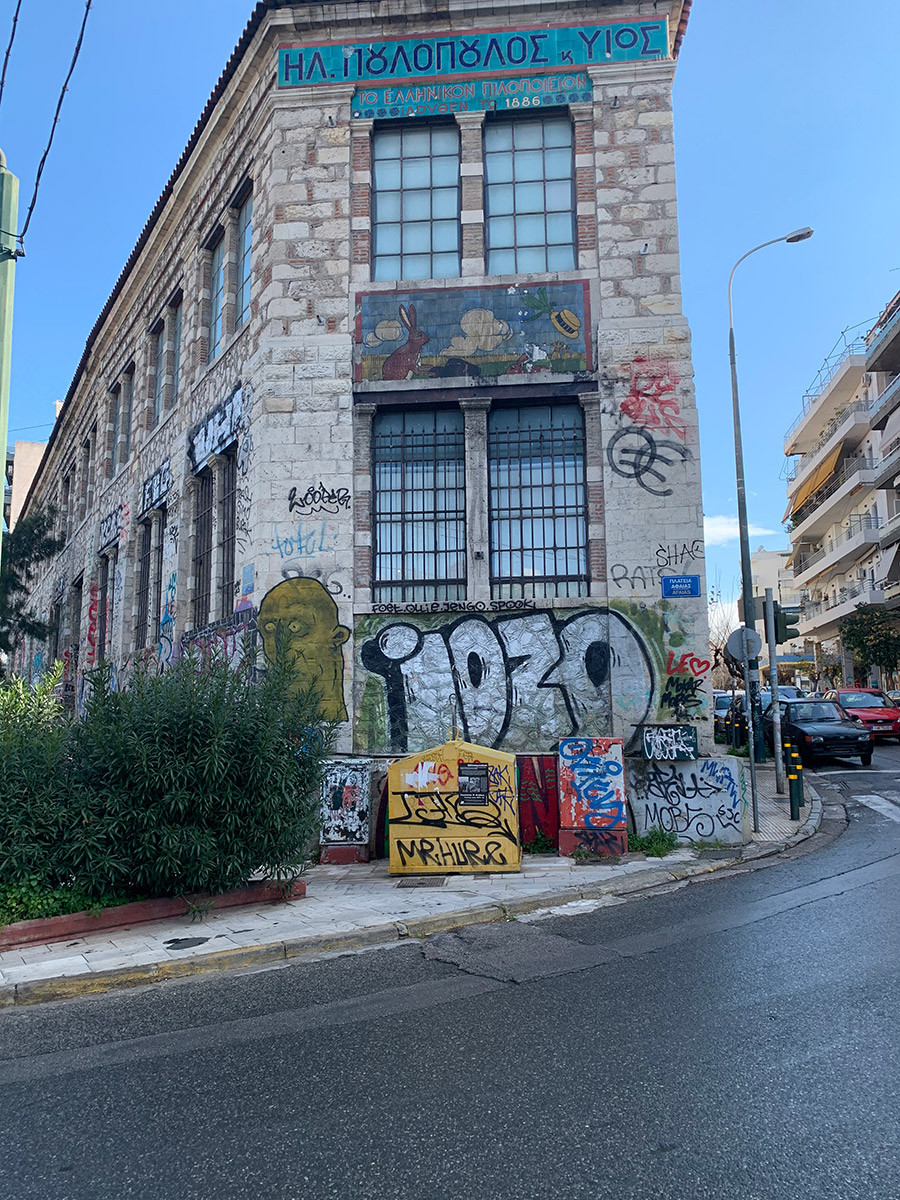“Pil-Poul” or Poulopoulos Old Hat Factory, now the Melina Mercury Cultural Center
A stone’s throw away from the trendy converted gasworks centers of Gazi in Technopolis , “Pil-Poul” as this old hat factory was known back in the early 1900’s, stands tall and imposing as one of the best examples of industrial architecture. It is situated in Athens’ popular Thission neighborhood, easily accessible on foot from the Thission train station.
This Center houses two permanent exhibitions. The first one, “Travelogue of Athens”, situated on the first floor, was organized with the participation of the Hellenic Literary and Historical Archive, and portrays the neighborhoods of Athens in the early 20th century. Sitting in one of the many chairs of the large exhibit room or quietly strolling around, you can admire the facades of reconstructed neo classical houses or peek through the windows of the various shops, where you can make out the variously dressed up manikins used to reenact scenes from the past. The Tambakis Tobacco shop stands next to the Barbershop where the barber has wrapped a white cloth around his client while they discuss trim preferences. On the top floor of the house where the two shops are, two Caryatid figures stand guard on the balcony. A couple sit at an outside café further on, enjoying a respite from busy city life. A propped up sign advertises the Poulopoulos hats nearby and you can see the photographer Konstantinos Apostolou in his shop, leaning back against the wall, camera at the ready, waiting for customers. The pharmacist is on duty, and waits to measure the precise dosages of medicine that will be required, and the Grocery shop is stocked up high on all produce. At the Konstantinidis Bros Printing shop, the printer is busy at his machine fulfilling various orders while next door a sign reads that the Mayor accepts visits only in his office. And ladies, you must dally a while at the large Novelty Shop which caters to all fashion requests from authentic period dresses and hats to gloves and jewelry.
Snapping back into present time, you can admire the second permanent exhibition on the ground floor, the Haridimos Shadow Theater Exhibit, which has been housed here since September 2006. The rich Haridimos collection which numbers over 1000 exhibits, includes figures of the Karagiozi theatre made from leather and other materials, books, paintings and photo documents. This family legacy spans three generations of the Haridimos family, dating back to 1913, with the grandson Sotiris continuing the tradition today with his participation in cultural events and Folk Art Education programmes, involving the construction of the puppet figures and sets. The poor, struggling, hunchbacked figure of Karagiozi down on his luck , with his long right hand, ragged clothes and bare feet, living with his wife and three sons across the Palace of the Sultan, has been popular in both Greek and Turkish folklore, entertaining generations of young and old alike. School children are regularly brought to this exhibit where they learn about the characters and the intricacies of constructing the figures and sets.

The Center also holds temporary exhibitions, events, concerts and seminars in two halls, one of which measures 380 sq. meters and is 5 meters high to accommodate large scale exhibits. Opening hours are from 10am to 8pm on Tuesday to Saturday, from 10am to 2pm on Sunday and on Monday it is closed. The entrance is free.
Going back to the historical foundation of this impressive building, we learn that it was built in 1896, and was originally a single-storey structure with the second storey added later on. Its industrial design incorporates curved stone and rectangular columns with neo-classical elements and a tiled roof. The tall closely spaced iron framed windows lets in ample natural light on all of the exhibition rooms inside.
Originally a draper from Kalamata, Ilias Poulopoulos arrived in Athens and founded the Hellenic Hattery in 1886, one of the most successful businesses of the time. When he built the factory in Thission, it originally occupied an entire city block and in its peak between 1920-1930, employed over 400 workers and was the largest hat-making factory in the Balkans. His hats were highly popular and won international prizes. The business continued until the mid 20th century. It was damaged heavily during the Second World War and it is said that damage from shrapnel and bullets were evident on the walls. In 1988, it was bought by the City of Athens and restored to its present state.
The walk down the pedestrian street of Herakleidon, off Nileos Street, towards the old Poulopoulos hat factory at the end of it, is a juxtaposition of past and present. You walk down past the century old neoclassical houses of the tree lined street with the abandoned tram line in the middle, and circumvent the archeological remains of part of the fortification wall of Athens a little further down. Bars, cafes and restaurants right and left entice you to sit and partake of food and drink, but as you continue on, the historical houses give way to modern day apartment buildings until you reach the Melina Mercury Cultural Center. As with everything else in Greece, any visit will be highlighted by past history intruding into the present. Enjoy the voyage!
Cover Photo Credits: Athens Insiders